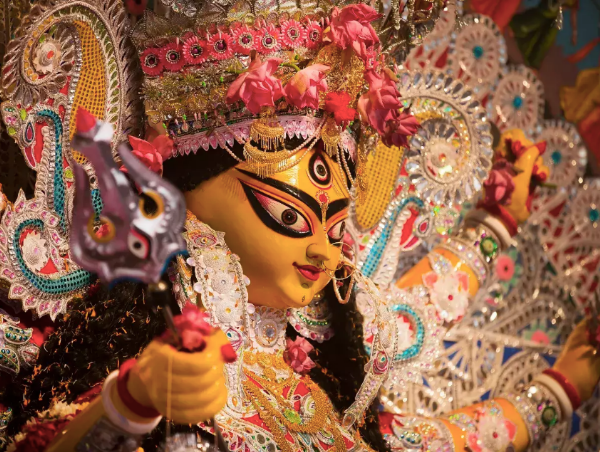Various shades of Navratri across India
Different states in India celebrate Navratri in their own unique ways, with their unique traditions
Total Views |
In India, Navratri is one of the most widely celebrated festivals. The celebration is not constricted to just one state, but is different in different states. Navratri basically is the celebration of Nine Nights, when Maa Shakti or Durga Ma is worshipped. Thinking that Navratri is a festival only Gujaratis celebrate, is a mistake, because it is celebrated all over the country in different ways. The basic reason for the celebration remains the same – which is the victory of good over evil, and to get the blessings of the reincarnations of the Goddess. Different states in India celebrate this festival in own unique ways, with their unique traditions. Here are a few ways in which it is celebrated:

Tamil Nadu –
Navratri is celebrated in Tamil Nadu as a religious celebration seeking the blessings of Goddess Durga, Goddess Lakshmi and Goddess Saraswati on the 9 special nights. These 3 goddesses are worshipped for 3 days each. Friends, relatives and neighbours are invited. Clothing, jewellery, sweets and gifts are exchanged.
An interesting feature of this celebration is the decoration of the ‘Kolu’ - that is actually a staircase which has 9 stairs. These 9 stairs represent the 9 nights. Each stair is decorated with lovely dolls, and idols of gods, goddesses. The dolls used get handed over from one generation to the next.Himachal Pradesh -
In Himachal, Navratri is a one of the biggest celebrations for the Hindus. Here, the celebration starts on the 10th day of Navratri - when the festival actually ends in most other states. People celebrate the 10th day - also called as ‘Kullu Dussehra’, as the day of return of Lord Ram to Ayodhya. On this day, idols from temples are taken out in processions. During the Navratri, the devotees visit numerous temples in Kangra, Una and Bilaspur in Himachal Pradesh, to worship Goddess Durga.
Punjab -
In Punjab, the people fast on the first 7 days of Navratri and end their fast on Ashthami or on Navami. They worship 9 young girls and a boy, which is popularly known as ‘Kanjika’. The Punjabis organize their jagratas where they are awake during the whole night, worshipping Goddess Shakti.
Maharashtra -
The celebrations are in Maharashtra are similar to those in Gujarat. Navratri, in Maharashtra, implies to new beginnings. So, the purchasing of a new home or a car indulging in new business deals / engagement is very common during this time period. Married women invite their female friends, apply haldi and kumkum on foreheads and gift them a coconut, beetle leaves and beetle nuts. This gesture is called as ‘Saumangalyam’ meaning - remaining the wife of her husband until her death. Some localities in Maharashtra also have their own garba and dandiya night celebrations.
Kerala -
In Kerala, Navratri is celebrated in the last three days and Keralites give importance to learning during these three days. They place books and musical instruments in front of Ma Saraswati’s idol on Ashtami, and worship the books and Ma Saraswati till Dashami. On Dashami, the books are taken out for reading.
Andhra Pradesh -
It is celebrated as ‘Batukamma Panduga’ in Andhra. It means to ‘Come Alive Mother Goddess’. The 9 nights are a dedication to the Goddess Shakti. Women make flower stacks called ‘Batukamma’. These are arranged with seasonal flowers. Women perform pujas in front of Batukamma. On the last day, they set their Batukammas afloat in a lake or a nearby water body.
West Bengal -
In West Bengal and in most eastern states like Assam, Tripura, Odisha and Jharkhand, Navratri is celebrated as Durga Puja, the main annual festival for Bengali Hindus that commemorates the victory of Durga over the shape-shifting buffalo demon Mahishasura. During the celebrations, elaborately designed pandals (marquees) and life-size statues of the goddess Durga are installed here in every neighborhood. Dressed in traditional attire, devotees offer prayers in the evening and perform a Chunichi naach, a special dance with earthen lamps.
Gujarat-
Of course, Gujarat has a unique way of celebrating Navaratri. And it is this version of the celebrations that have seeped into popular culture. Devotees observe fast for nine days to honor Durga and her nine different incarnations. Navratri in Gujarat is also known for the Garba Raas, a traditional dance performed by men and women around the garbo or an idol of Durga. The word Garba or Garbha means womb and in this context, the lamp in the pot, symbolically represents life within a womb.
Gujarat-
Of course, Gujarat has a unique way of celebrating Navaratri. And it is this version of the celebrations that have seeped into popular culture. Devotees observe fast for nine days to honor Durga and her nine different incarnations. Navratri in Gujarat is also known for the Garba Raas, a traditional dance performed by men and women around the garbo or an idol of Durga. The word Garba or Garbha means womb and in this context, the lamp in the pot, symbolically represents life within a womb.

